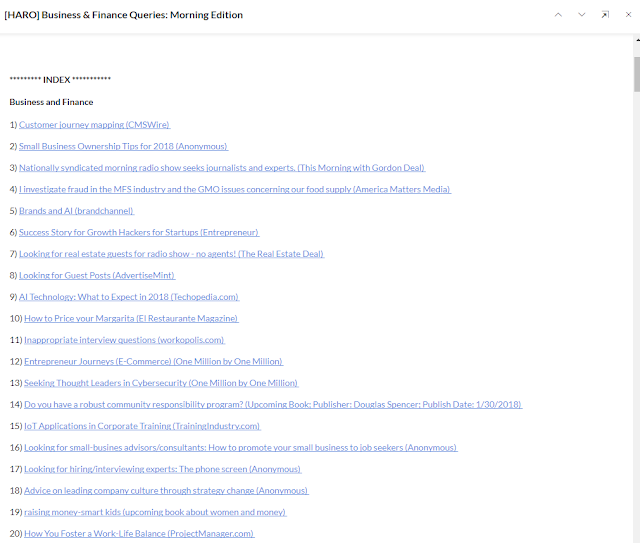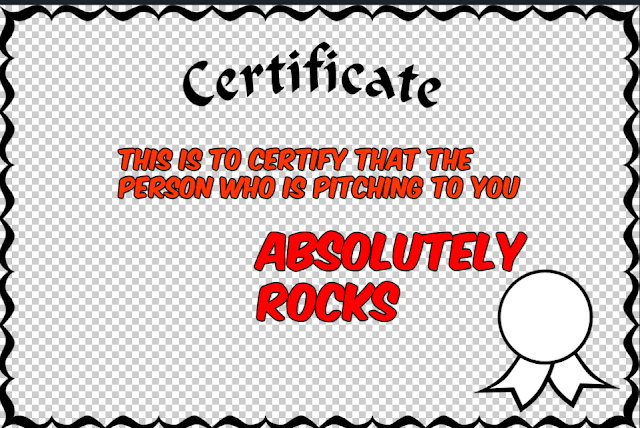But for the uninitiated, HARO is acronym for Help A Reporter Out. The name couldn’t be more true to its function. Basically it is a platform where influencers and experts connect with reporters and journalists.
It helps you build links, get branding, exposure and PR – all for free, provided you know how to use it like a pro.
And in this post, you’ll learn just that!
What is HARO?
It is a platform for reporters and journalists to get quick and fast knowledge and sources and bloggers to get links and exposure. If you can use HARO correctly, you are sure to get huge PR success as evidenced by numerous experts and influencers in each and every niche.
- How to Grow Your Business Online: A Definitive Guide
- Skyrocket Your Email List by These 32 Tactics
- All You Need to Know Before You Hire an SEO
Sources, do however, have to register. Upon registering as a source, you get emails thrice daily on weekdays. You can even select the type of queries which you want to be delivered to you by email.
Each of the queries delivered to you, need to be answered within the mentioned deadline. If a journalist happens to like your pitch, they will publish it in their website.
HARO is an amazing platform to grab chances of getting featured in top publications which you are unlikely to get anywhere else. It also offers you the chance of meeting tons of influential people in and around your niche.
If you happen to master the art of pitching and do take the time and patience of applying the techniques mentioned here to your pitches, you will be sure to get amazing success in building links and gaining exposure when using HARO.
But for each and every success story that is out there, you should know that there are more than a thousand failures who send emails after emails hoping to get some mentions and link-backs but unfortunately keep on failing.
- Related Read: Free and Exclusive List on the Best Posts to Learn All About SEO
- Your Entrepreneurship Traits And Why It Matters To Your Business
Since I have been using HARO for a long time now, I will be laying down the fundamental principles of rocking at HARO and getting your dream exposure, plus a quick hack method of getting more links and social shares without even pitching!
How To Find Opportunities in HARO
HARO has a huge list of subscribers i.e, sources. So, journalists from reputed sites get a huge number of pitches. As such, it is quite difficult to succeed at HARO, if you don’t work for it.
Trisha Beausaert, who is the Public Relations Manager at Voices.com, the industry-leading website that connects businesses with professional voice talent, says:
Nancy Cleary of Wyatt-MacKenzie Publishing says:
There are several other HARO success stories, which you can read through this link, if you want to.
Anyways, without further ado, this is how you start!
First, to sign up in HARO as a source, go to this link.
Click on the “I’m a source button”. Scroll down and click on the Subscribe button. Select the free option or you may select any one of the premium options too.
I have listed the benefits and whether or not you should go for a premium account in a later section of the post.
When you set up your account, you will be asked which category of emails you want to receive. Be sure to select a specific category or you will be overburdened by the tons of queries that props up in the general category.
There are several categories for you to choose from, as listed below:
- Business and Finance,
- High Tech
- Biotech and Healthcare
- Energy and Green Tech
- Lifestyle and Fitness
- Sports
- Entertainment and Media
- Public Policy and Government
- Education
- General
- Giftbag
- Travel
- UK
Since I have two blogs – WinSavvy and TechSavvy, one of which is oriented towards business and the other tech, I have those two categories checked.
HARO emails are sent thrice daily at 5:45 am, 12:45 pm, and 5:45 pm (EST) every day.. Do not try to pitch for each and every request. First make sure that you are actually qualified to answer the queries.
Journalists usually check on the authenticity of the pitches they receive, so having some credentials on the matter will help you a lot. Even more important is sending unique pitches that add value. Simply Googling up content for the pitches and sending them to the journalists won’t do you any good.
There are a lot of people who shall be doing the exact same thing. So, writing something that others won’t have thought about does have an extreme benefit and can tremendously increase your success rate.
Plus, since there are so many emails that warrant your attention, try to answer only those that you are most confident in. Pitching for too many requests is sure to burn you out very fast.
Do These To Succeed At Haro
- Be Prompt
- Craft a killer Subject line
- Give an Unique Answer
- Give your credentials and make sure you actually qualify for pitching
- Keep the pitch short
#1. Being prompt,
when answering queries is quite important and even more-so when it comes to queries from big publications like Forbes or Huffington Post. Journalists from these major publications get more pitches than they seek for, often numbering in the hundreds.
This makes them at times send their queries as anonymous. So, you may want to capitalise on the anonymous requests that you get there.
Anyhow, if it is a major publication, you should send in your pitch within the first 20 minutes. If not, consider your chances of selection near zero, although you can get a chance if you are able to craft a killer subject line.
If it is not a major publication site, then try pitching within eight hours at most. The reason behind being prompt is that most people who are sending out these queries will get what they need within the first ten pitches that they get.
So, it is imperative on your behalf to be within the first ten.
I said it in my post on How to Create a Viral Blog Post, that a headline is one of the most important feature of a post as it is what draws a viewer in. And, in this case it couldn’t be more truer (I mean the subject line, here).
#2. What makes a good subject line?
Using numbers, making outlandish promises and putting in questions are, in short, the ways you rock your subject line. I have gone over how to write an awesome headline in detail in the post on how to write a post for links and social shares!
So do positively check it as it has got several important takeaways to craft an awesome headline.
Now suppose, if there is a query on “best phones for international travel”, giving a pitch with the subject line just as it was in the query will not get you selected.
However, creating the subject line as “The #1 Phone that I Always Take for My Trips Abroad” makes your pitch stand out from the crowd and gives you a great chance of getting selected.
Now for the third part, which is,
#3. Giving a unique answer
If you don’t know the answer to a query or are not much knowledgeable with the subject, I suggest that you skip it.
You could always just Google up the answer to their queries but it is quite obvious that the journalist would have done so too. Plus, there will be several sources just like you who will have pitched answers by Googling them.
So, your chances of getting selected is quite slim if you try that.
The reason why journalists send queries is because they want some unique perspective on the issue by people who are experts in the field and have got adequate knowledge on the subject.
Giving an unique answer will make your pitch stand out from the rest and will be definitely selected.
#3. Credentials matter
A journalist who has sent a query on the latest trends on biotechnology wants an answer from an expert in the field and not from one who ownes a bakery shop.
Better give your credentials and expertise before you start your pitch. Some people also send it at the end and that works too. What’s important is just giving 2 or 3 lines showing why the hell your pitch counts on the topic.
#4. Keep it short
The journalist doesn’t want you to do the article they are working on for them. All they want, is an insight on certain topics or your unique perspective. So, do keep it short.
Try to keep the pitch excluding the credentials within 200 words although that’s more of an oversimplification.
The shorter and crisper the pitch is, the better.
#5. Never Exclude the Journalist’s Name
I understand pitching again and again to journalists at HARO is rather a tiring process. But, using a generic template when you pitch decreases your chances of getting selected as almost everybody on Earth dislikes emails that are not personalised.
You don’t need to research a journalist. But at least, when a query isn’t anonymous, you should pay enough heed to include the reporter’s name in your pitch.
Mistakes that Will Definitely Make You Fail In HARO
This part is quite the opposite of the previous one. However as the quote goes:
“All I want to know is where I’m going to die so I’ll never go there”;
this section speaks of all the mistakes that you probably do but shouldn’t be doing.
When I write guest posts or articles as a freelance writer for different websites, I try to give my best, if the site I am writing for, is a high authority website. And, for that I pitch certain queries as a journalist through HARO.
And, the pitches I receive, get me quite worked up.
Honestly.
Here are the reasons why and also the stuff that you should never do.
#1. Not Reading the Go*damn Query
Most of these pitches are completely out of the context, which forces most, if not all, journalists to hit delete.
Some of the remaining have just a one-line pitch; something like,
“Hi [Name], I am the [designation] and I would love to connect you with [Name], who has some wonderful insight to share with you on this topic.”
If you send pitches like that, stop, because the chances of the journalist reverting back to you, is very slim.
#2. Sending a Pitch full of Spelling and Grammatical Errors
When someone sends a query through HARO, they are typically looking for a pitch which they can copy and paste into their article. So, you are not making their job any easier by making them scan through your pitch trying to make it eligible for the audience, when and if, they post it.
Thus, they will just hit “delete”.
There are two other reasons for this too:
- The journalist may think you to have poor command over English (and not well-read) and may ignore your pitch.
- He may also think that you don’t care and shouldn’t be relied upon for whatever he is working on.
In a post by Erika Madden at Olyvia.co, she mentions that she once talked to an entrepreneur who doesn’t double check their pitches because according to her,
anyone she encountered in her business who cared that much about spelling or grammar was not “meant for her.
But if you read what she says afterwards, you’ll see she mentions that journalists do care about spelling and grammatical errors.
The thing is, try making it easier for journalists as they are quite burdened with their work. Most of them do not have time to correct your mistakes for you.
#3. Copying Content from Websites into your Pitches
I get so pissed when I find pitches of different fonts after I post a HARO query. In fact, once, long back, when I was creating a post on Applications of Augmented Reality, there was a guy who just copied up entire sections of Wikipedia!
Needless to say, I hit delete immediately.
Even if you match the fonts, a simple Google search of copied content brings back results of the site you copied the content from. And if you are a little on the smart side, you may use Spinbot, to spin your post so that Google can not recognise it.
However, there are certain tools which recognise spun content, although not with 100% accuracy.
As such, it would be much lesser work and bring a greater success rate for you, if you don’t copy and paste content but add your individual take on the subject.
#4. Creating a Boring Pitch
Nobody likes to be tortured. And, reading boring stuff is torture. That’s why kids hate going to school as they have to read boring books. Adults are not much different in this regard.
Be serious but not boring. Put in a joke; use the AIDA model while writing. Craft a catchy subject line. And that’s all you need to get your pitch selected.
#5. Making your Pitch too Long
Reporters can’t go through long pitches. They simply don’t have the time. They are just looking for short, thoughtful pitches. The longer your pitches are, the lesser your chances of getting selected.
#6. Don’t Lie to Get Yourself Selected
because, it rarely works. If you don’t fit into the requirements, don’t lie to get yourself in as a qualifier. Almost all journalists will check your website to see if you are actually what you say you are.
If you don’t qualify in the requirements of a certain pitch, then just chill and wait for the next HARO email!
#7. Don’t Mispell the Journalist’s Name
Why?
It is damn unprofessional! That’s Why!
I have received so many emails calling me Adeep, Adip, and Ahip, that I have given up all hopes for these poor souls. Though, I do read their pitches with the same attention as I give to those who get my name right, most won’t.
Should You Upgrade to A Paid Subscription or Use the Freemium Version?
With premium subscriptions, you can use keywords to search queries according to your wishes. Automatically inserting your bio in a pitch, when you reply to a query also saves you quite a lot of time.
The bio in a premium account contains links to your websites and social media accounts. It also lets you add details on your areas of expertise and any online publications you have been featured in.
Then, you also get a head start by being alerted whenever a query gets approved through the selection process. This lets you send in your pitches, much before anybody else does and that kind of solves the problem of being prompt!
While, I use the free version, going premium is entirely a choice that you should consider yourself. Here’s a screenshot from the subscription page of the plans that HARO offer.
The Secret to Gaining Links Crazy Fast in HARO (aka The Cheat)
P.S. I do not endorse or support this, so don’t sue me!
The Pre-Pitching HARO Checklist

Conclusion to Rock HARO
#1. Send a Thank You Note
“Hi [Name], thanks for including me in your roundup. I will be sure to share it among my social media platforms.Cheers,Name”
#2. Share Vehemently
#3. Ask them if you can guest post at their website (Optional)
If you get selected, it’s because the journalist liked your pitch. And it is your job to leverage that. He will be more receptive to accept your guest posting request rather than if you come across cold. Plus, if it is a top site in your niche, this point is all the more important.
Must Reads:
- Read Next: 45+ Apps Entrepreneurs Use to Increase Their Productivity
- How You Can Get Followers and Build Engagement via Instagram Giveaways
Now it’s your turn. Comment and Give some social media love.






































